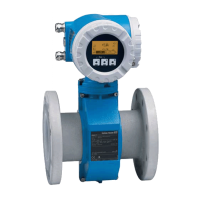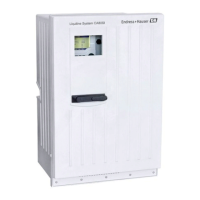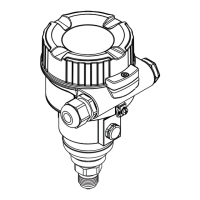What to do if the Endress+Hauser Gammapilot FMG50 data storage is inconsistent?
- AAlbert AndradeSep 23, 2025
Restart device. Contact service.

What to do if the Endress+Hauser Gammapilot FMG50 data storage is inconsistent?
Restart device. Contact service.
What to do if the Endress+Hauser Gammapilot FMG50 Measuring Instruments device cannot be operated via SmartBlue?
If the device cannot be operated via SmartBlue, ensure that you are entering the correct password. If the password has been forgotten, contact Endress+Hauser Service. In case the sensor temperature is too high (over 60 °C or 140 °F) due to ambient temperature, Bluetooth communication may be disabled. Shield the device, isolate it, and cool it down if necessary.
What to do if Endress+Hauser Gammapilot FMG50 Measuring Instruments device is visible in live list but cannot be accessed via SmartBlue on Android?
If the device is visible in the live list but cannot be accessed via SmartBlue on an Android device, ensure that the location function is permitted for the app. Some Android versions require GPS or positioning function to be activated. Close the app fully, restart it, and enable the positioning function for the app.
What to do if pulse rate is too low with empty vessel for Endress+Hauser Gammapilot FMG50?
If the pulse rate is too low with an empty vessel, the radiation source might be switched off; switch it on at the source container. The source housing might be incorrectly aligned; realign the angle of emission. Buildup in the vessel could be the cause; clean the vessel or recalibrate if the buildup is stable. Also, fittings or pressure in the vessel might not have been considered in the activity calculation; recalculate activity and change the radiation source if required. Check if there is no radiation source in the source container; load radiation source. The radiation source may be too weak; use a source with higher activity. If a modulator is used, make sure it is mounted correctly. If a collimator is used, ensure correct alignment of the radiation entry window.
Why is pulse rate too high with empty vessel for Endress+Hauser Measuring Instruments?
If the pulse rate is too high with an empty vessel, the activity might be too high. Attenuate radiation, for example, by mounting a steel plate in front of the source container, or replace the radiation source. External radiation sources might be present; shield off if possible and repeat calibration without the external radiation source.
What to do if the Endress+Hauser Gammapilot FMG50 operating temperature is out of range?
Check ambient temperature. Check process temperature.
What to do if the Endress+Hauser Measuring Instruments supply voltage is too high?
Decrease supply voltage.
What to do if the Endress+Hauser Gammapilot FMG50 loop current is faulty?
Check wiring. Replace electronics.
What to do if the Endress+Hauser Measuring Instruments module is incompatible?
Check if correct electronic module is plugged. Replace electronic module.
What to do if the Endress+Hauser Gammapilot FMG50 pulse rate is out of range?
Check process conditions. Check environmental conditions. Replace device.
| Measuring Principle | Gamma radiation |
|---|---|
| Housing Material | Aluminum or Stainless steel |
| Application | Level measurement in liquids and bulk solids |
| Process Temperature | -40 to +80 °C |
| Process Pressure | Up to 40 bar |
| Output Signal | 4-20 mA, HART |
| Protection Class | IP66 |
| Communication | HART |
| Certificates/Approvals | ATEX, IECEx |
| Ambient Temperature | -40 to +60 °C (-40 to +140 °F) |
Explains the purpose and scope of the operating instructions.
Explains safety and information symbols used throughout the manual.
Details personnel qualifications and intended applications.
Emphasizes trained specialists and safe operation practices.
Covers radiation safety guidelines, shielding, time, and distance.
Explains CE and EAC conformity marks.
Details the physical design and lists main components of the FMG50.
Explains device nameplate information and lists accompanying documents.
Covers checks upon receipt, identification methods, and storage.
Discusses general mounting principles and optional features.
Details mounting for Level, Density, Interface, and Concentration measurements.
Lists essential checks after the device has been installed.
Covers compartment, HART, terminals, cables, protection, and connectors.
Details connection options for the RIA15.
Provides wiring steps and examples for various applications.
Lists checks after wiring and mentions SIL application requirements.
Lists HART protocol, FieldCare/DeviceCare, RIA15, and WirelessHART operation.
Covers local, service interface, RIA15, Bluetooth, and SmartBlue App operations.
Explains software and hardware methods for locking configuration.
Details the process and types of device resets.
Stresses post-installation and post-connection checks before commissioning.
Guides through device identification, measurement settings, and calibration.
Explains background, point level, and full calibration processes.
Details density compensation using RSG45.
Details error signals, types, and calibration errors.
Troubleshoots issues with the SmartBlue app.
Explains event display and lists diagnostic events with remedies.
Covers principles, reaction, limits, settings, and parameters for gammagraphy.
Explains clock function and setting the real-time clock.
Covers exterior cleaning, repair process, and Ex-certified device repairs.
Discusses replacement procedures, calibration, and HistoROM usage.
Covers ordering parts, device return, disposal, and contact info.
Lists Commubox and Field Xpert devices.
Covers retaining brackets, clamps, and pole mounts with dimensions.
Lists various FHG51 clamping device models for density measurement.
Details the RIA15 and its required HART communication resistor.
Refers to the "Technical Information FMG50" document.
Lists various technical information and accessory documents available.
Covers Functional Safety (SIL), Heartbeat, and Ex approval details.
Lists other standards, certificate access, CE, EAC, and Overfill prevention.











